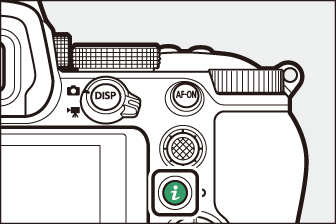Record two to ten NEF (RAW) exposures as a single photograph.
|
Option |
Description |
|---|---|
|
[] |
|
|
[] |
Choose the number of exposures that will be combined to form a single photograph. |
|
[] |
|
|
[] |
|
|
[] |
|
|
[] |
Choose the first exposure from the NEF (RAW) images on the memory card. |
Creating a Multiple Exposure
-
Highlight [] in the photo shooting menu and press 2.

-
Choose an option for [].
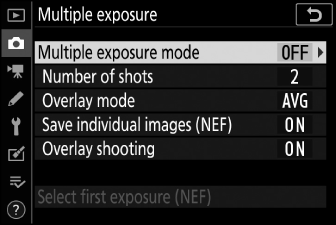
-
Highlight [] and press 2.
-
Highlight a multiple exposure mode using 1 or 3 and press J.
-
If [] or [] is selected, an icon will appear in the display.
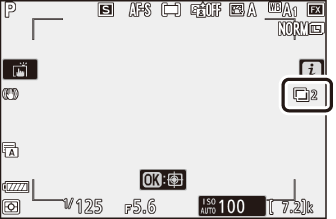
-
-
Choose a value for [] (number of exposures).
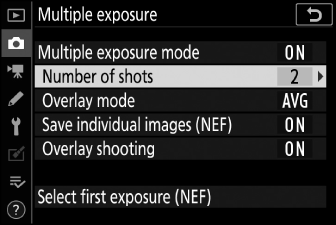
-
Highlight [] and press 2.
-
Choose the number of exposures using 1 or 3 and press J.
-
-
Choose an option for [].
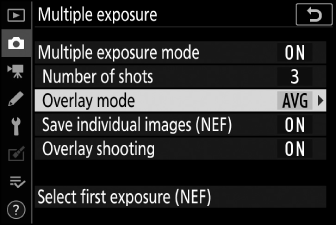
-
Highlight [] and press 2.
-
Highlight an option using 1 or 3 and press J.
-
-
Choose a setting for [].
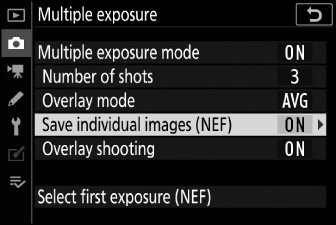
-
Highlight [] and press 2.
-
Highlight an option using 1 or 3 and press J.
-
To save both the multiple exposure and the shots that make it up, select []; the individual shots are saved in NEF (RAW) format. To save only the multiple exposure, select [].
-
-
Choose an option for [].
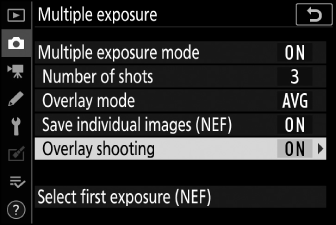
-
Highlight [] and press 2.
-
Highlight an option using 1 or 3 and press J.
-
Select [] to superimpose earlier exposures on the view through the lens. You can use the earlier exposures as a guide when composing subsequent shots.
-
-
Choose an option for [].
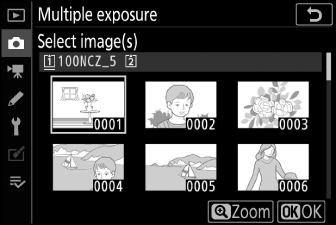
-
To choose the first exposure from existing NEF (RAW) photos, highlight [] and press 2.
-
Use the multi selector to highlight the desired picture.
-
To view the highlighted picture full screen, press and hold the X button.
-
After highlighting the desired picture, press J.
-
-
Start shooting.

-
Take the selected number of shots. If you used [] to select an existing NEF (RAW) image as the first exposure in Step 7, shooting will start from the second exposure.
-
Once you have taken the selected number of shots, the pictures will be overlaid to create a multiple exposure. Multiple exposures are recorded in JPEG format regardless of the option selected for image quality.
-
If [] is selected for [], you can continue to take additional multiple exposures until [] is selected.
-
If [] is selected, the camera will exit multiple exposure mode once the number of shots selected in Step 3 has been taken.
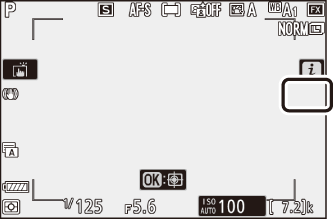
-
The i Menu
Pictures can be viewed by pressing the K button while a multiple exposure is in progress. The most recent shot in the current multiple exposure is indicated by a $ icon; pressing the i button when this icon is present displays the multiple exposure i menu.
|
|
|
-
Highlight items and press J to select.
-
You can also have the option of using touch controls after pressing the i button.
|
Option |
Description |
|---|---|
|
[] |
View a preview created from the exposures recorded to the current point. |
|
[] |
Retake the most recent exposure. |
|
[] |
Create a multiple exposure from the exposures taken to current point. |
|
[] |
Exit without recording a multiple exposure.
|
-
If you use the menus or view pictures in the display while shooting a multiple exposure, remember that shooting will end and the multiple exposure will be recorded if no operations are performed for about 40 seconds (or in the case of menus, about 90 seconds). The time available to record the next exposure can be extended by choosing longer times for Custom Setting c3 [] > [] or [].
-
Multiple exposures may be affected by “noise” in the form of randomly-spaced bright pixels, fog, or lines.
-
In continuous shooting modes, the camera records all exposures in a single burst. If [] is selected, multiple exposure shooting will end after the first multiple exposure is recorded. If [] is selected, an additional multiple exposure will be recorded each time the shutter-release button is pressed.
-
In self-timer mode, the interval between each shot in the exposure is selected using Custom Setting c2 [] > []. Regardless of the value selected for the c2 [] option, shooting will however end after the number of shots selected for the multiple exposure.
-
Multiple exposures may end if settings are changed while shooting is in progress.
-
Shooting settings and photo info for multiple exposure photographs are those for the first exposure.
-
Do not remove or replace the memory card while a multiple exposure is in progress.
-
Memory cards cannot be formatted while a multiple exposure is in progress. Some menu items will be grayed out and unavailable.
Multiple exposure cannot be combined with some camera features, including:
-
modes other than P, S, A, and M,
-
movie recording,
-
bracketing,
-
HDR (high dynamic range),
-
interval-timer photography,
-
time-lapse movie recording, and
-
focus shift
Ending Multiple Exposures
To end a multiple exposure before the specified number of exposures have been taken,
select [] for multiple exposure mode. A multiple exposure will be created from the exposures
that have been recorded to that point (if [] is selected for [], gain will be adjusted to reflect the number of exposures actually recorded).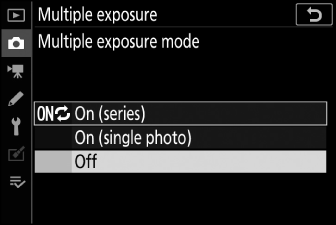
The multiple exposure will also end if:
-
the standby timer expires after the first exposure has been taken, or
-
you press the K button followed by the i button and select either [] or []



